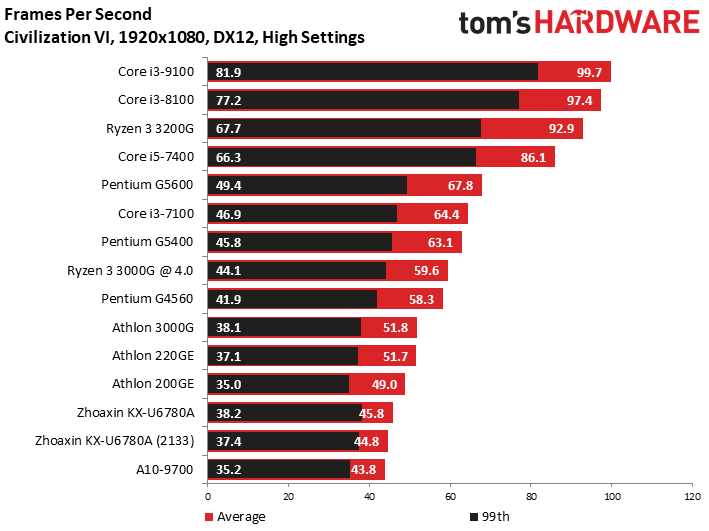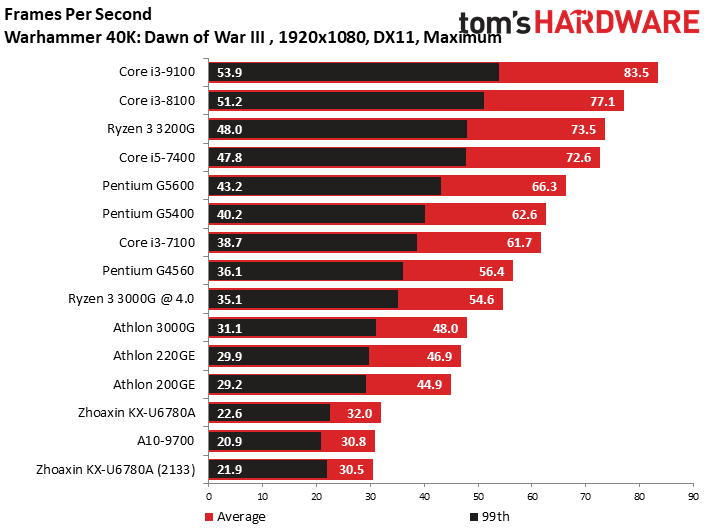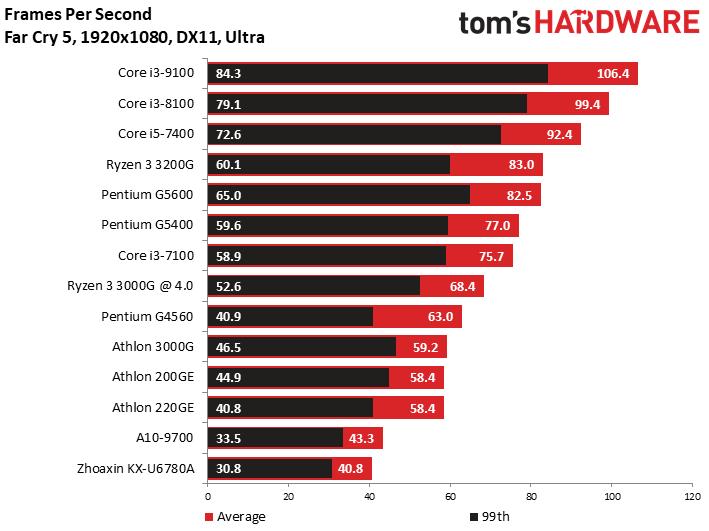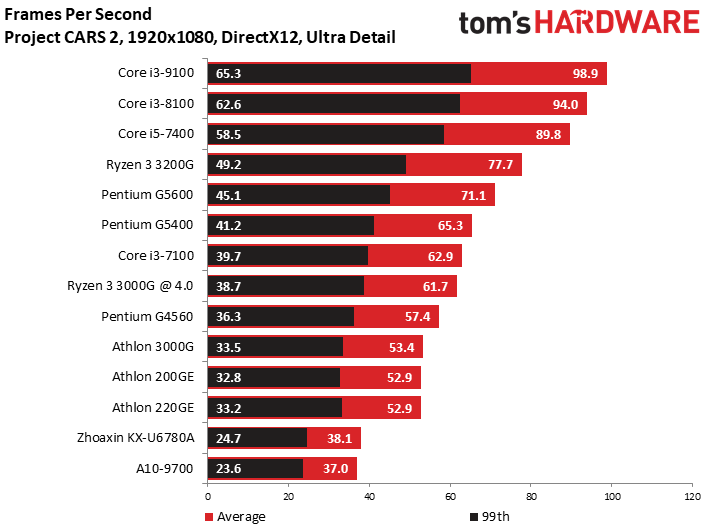Zhaoxin KaiXian x86 CPU Tested: The Rise of China's Chips
Taking on the x86 duopoly
Test Notes
We tested our game suite at both DDR4-2133 and DDR4-2666 and recorded performance deltas in a few titles. We've included DDR4-2133 results in the titles that experienced uplift beyond the normal standard deviation. That bodes well for Zhaoxin's future support for DDR4-3200, albeit with the stipulation that you'll need a pricey kit with the pre-defined DDR4-3200 SPD.
VRMark and 3DMark
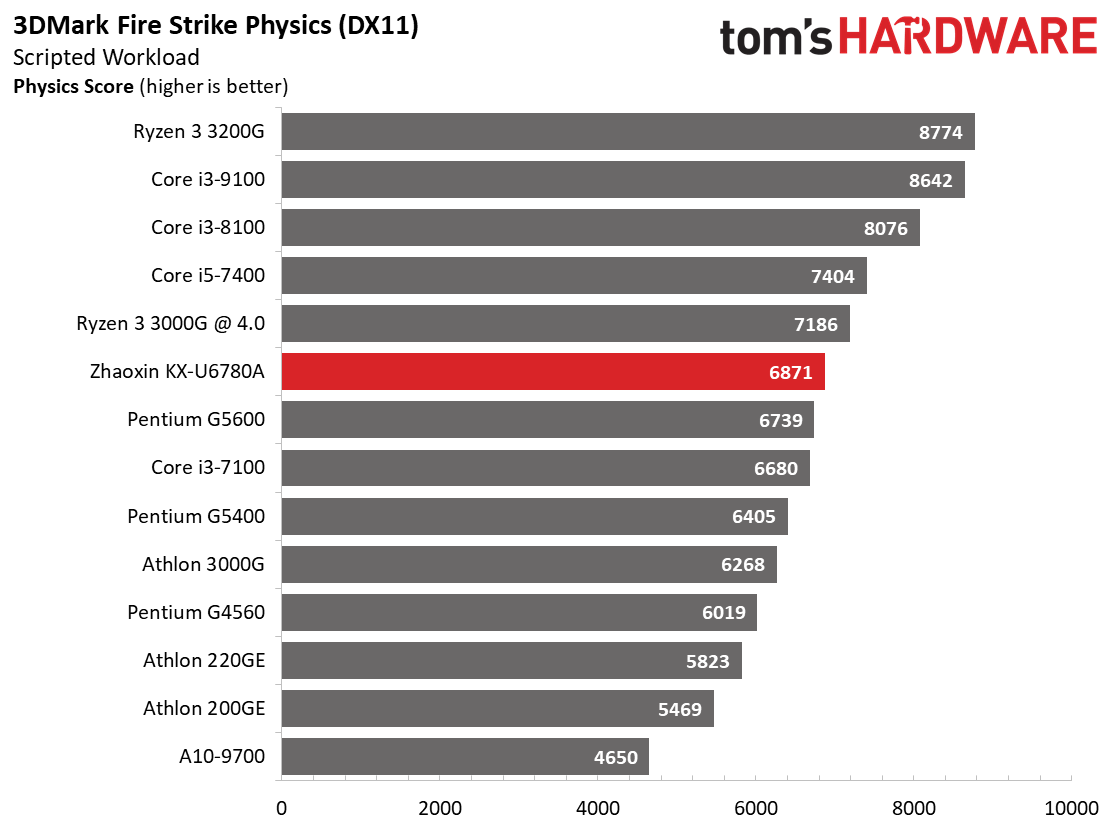
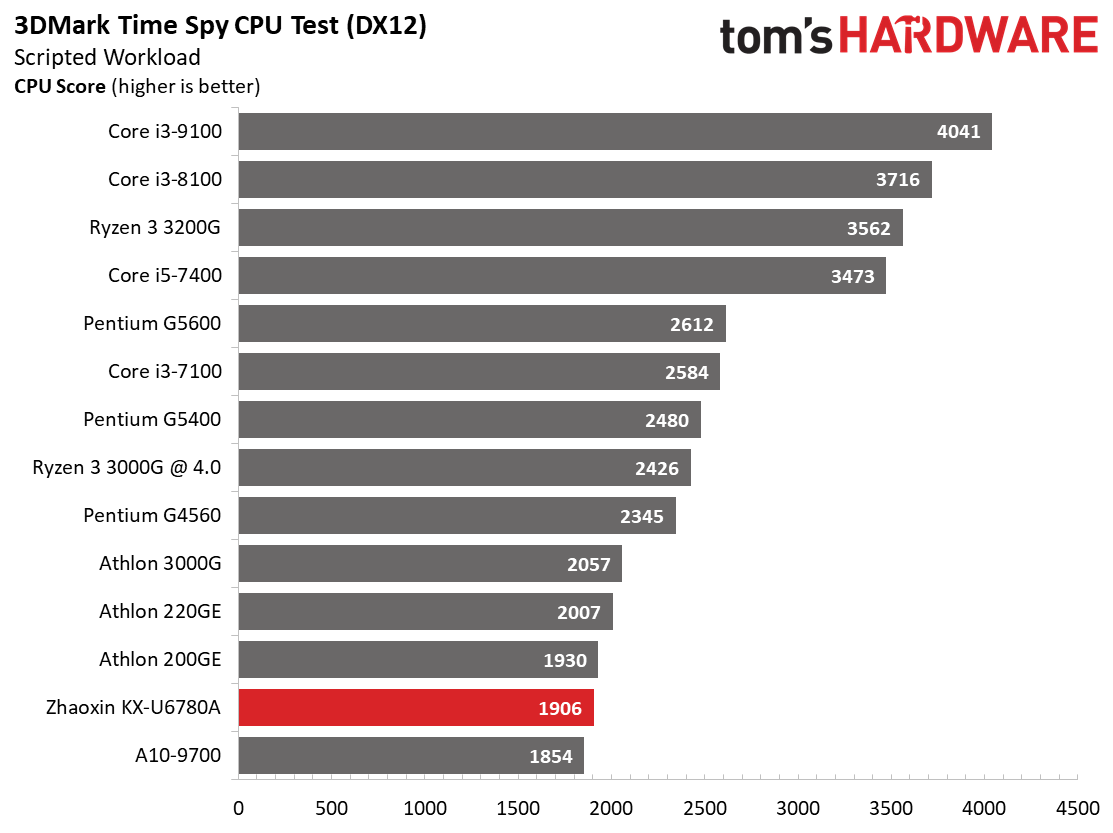
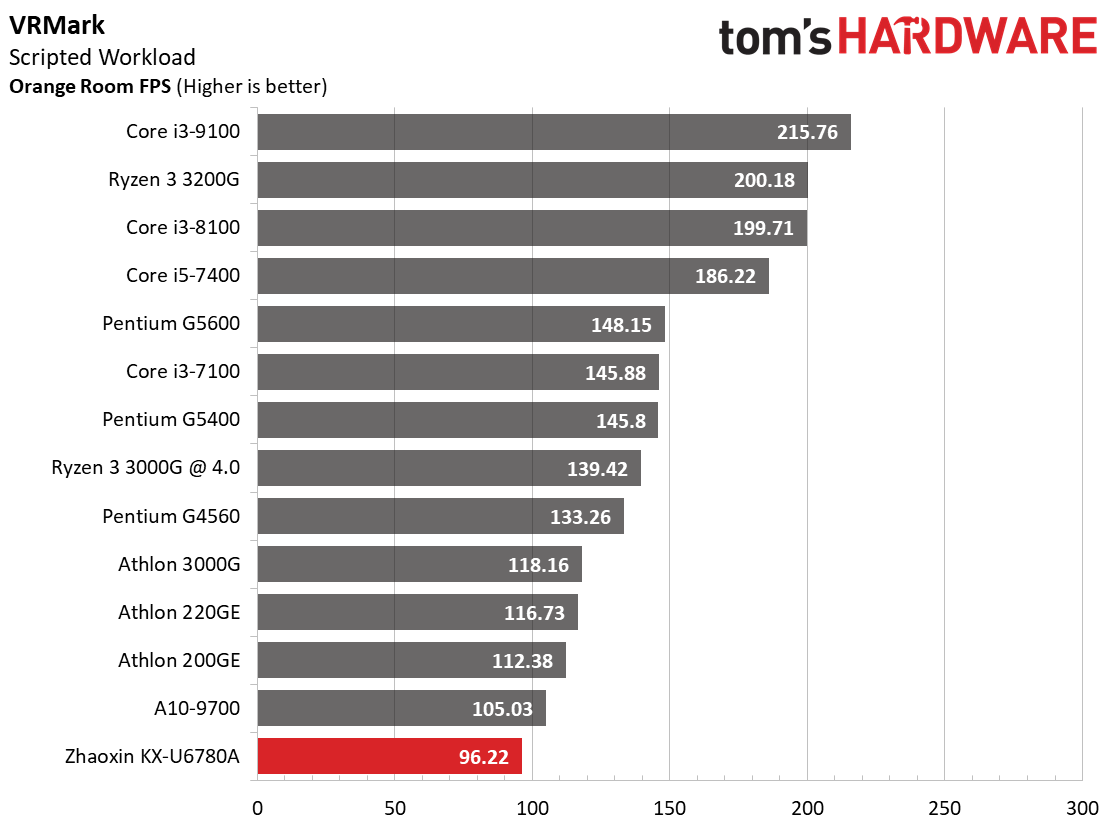
Synthetic gaming benchmarks often aren't indicative of real-world performance, but the 3DMark DX11 and DX12 tests measure the amount of raw computational horsepower exposed to the game engine. For now, most of today's game engines don't scale as linearly with additional compute resources, but these tests help us gauge how games could exploit processing resources as the engines become more sophisticated.
In the synthetic world of the Fire Strike benchmark, the Zhaoxin processor scales well and beats out nearly all of the dual-core competition, with the exception of the overclocked Ryzen 3 3000G. The Core i5-7400, which Zhaoxin has used as a comparison point, leads by ~8%, which isn't too bad of a showing for the newcomer. However, flipping over to the DX12 physics test finds the Zhaoxin processor barely edging out the AMD's Bristol Ridge A10-9700. The previous-gen Athlon processors, with a mere two cores to their name, also outperform the KX-U6780A.
VRMark test prizes per-core performance (a mixture of frequency and IPC), exposing the KX-U6780A's weakness in lightly-threaded workloads. Even the Bristol Ridge chip, which hails from 2016, sails past the Khaoxin processor. Meanwhile, the Core i5-7400 nears the top of the chart.
Civilization VI AI and Stockfish
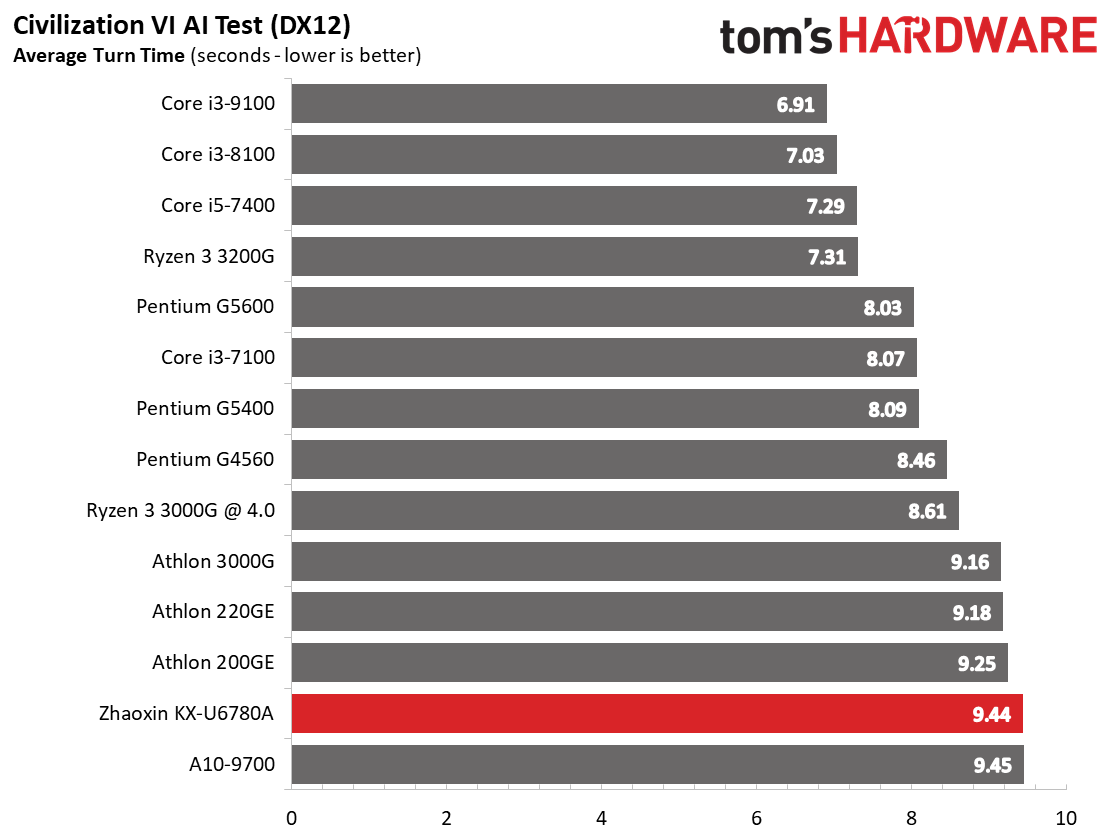
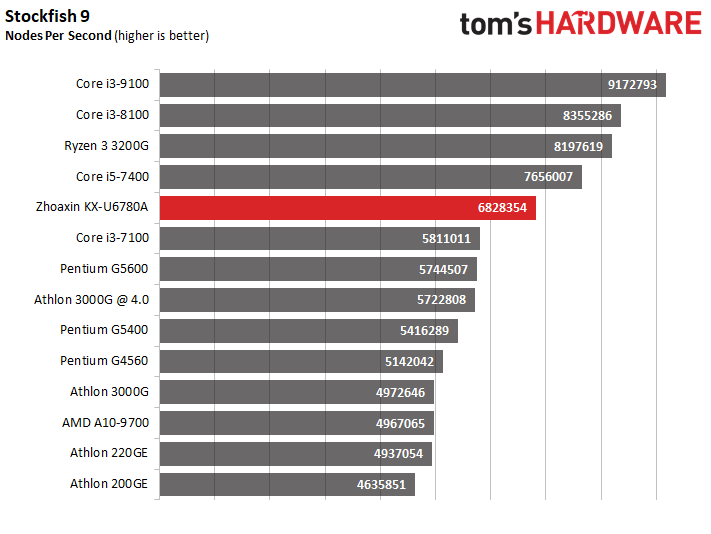
Civilization VI prizes per-core performance, so it isn't surprising to see the Intel chips take the lead in this test of AI engine performance in a turn-based strategy game. The KX-U6780A isn't as competitive here as a result of its lower IPC and constrained clock frequencies, but it is in range of the Bristol Ridge A10-9700 with its Excavator cores. Socket AM4 soldiers on, though, with much better performance in successive AMD generations.
Stockfish, an open-source chess engine, is designed to extract the utmost performance from many-core chips by scaling well up to 512 cores. That scalability meshes well with the KX-U6780A's eight-core design, but the four-core Intel i3 models continue to lead by a large margin.
Ashes of the Singularity: Escalation
Ashes of the Singularity: Escalation loves cores and threads, but clock rates obviously play a role. That certainly doesn't help the eight-core KX-U6780A as it falls to beat all but the A10-9700. Even the dual-core quad-thread Athlon 200GE pulls ahead by an impressive 24%, though it's obvious this class of processor isn't the best fit for such a heavily-threaded workload.
Get Tom's Hardware's best news and in-depth reviews, straight to your inbox.
Civilization VI Graphics Test
Civilization VI is known for its preference for high clock rates, so it's no surprise to find the Zhaoxin chip grappling with Bristol Ridge yet again. We do see the slightest of gains when we switch from DDR4-2133 to DDR4-2666, so the step up to DDR4-3200 could provide a bit more performance in the future. We wouldn't expect miracles, though.
Dawn of War III
The Warhammer 40,000 benchmark responds well to threading, but it's clear that Intel's clock speed and IPC advantage has an impact as the 8th- and 9th-gen chips take a solid lead. That isn't to discount the Ryzen 3 3200G, though, which musters a solid result given its price point. The Zhaoxin chip trails significantly.
Far Cry 5
Far Cry 5 tells a now-familiar tale, with the pecking order remaining largely similar throughout the remainder of our tests.
Final Fantasy XV
We run this test with the standard quality preset to sidestep the impact of a bug that causes the game engine to render off-screen objects with the higher-resolution setting. The Zhaoxin chip pulls up above the previous-gen dual-core Pentium G4560 by 4.9 fps, notching a much-needed win against an Intel chip. Those wins won't come often, though.
Hitman 2
We experienced significant hitching during the Hitman 2 sequence with the Zhaoxin processor, but the A10-9700 also provided lackluster performance.
Project Cars 2
Although Project CARS 2 is purportedly optimized for threading, clock rates obviously affect this title's frame rates. It's pretty clear that the KX-U6780A yields similar performance to the A10-9700 in most games.
World of Tanks enCore
The World of Tanks benchmark doesn't hold any surprises, with the KX-U6780A again trailing the test pool.
MORE: Best CPUs
MORE: Intel & AMD Processor Hierarchy
MORE: All CPUs Content
Current page: Zhaoxin Gaming Performance
Prev Page Zhaoxin IPC, Performance Scaling, and Power Consumption Next Page Zhaoxin Application Performance
Paul Alcorn is the Editor-in-Chief for Tom's Hardware US. He also writes news and reviews on CPUs, storage, and enterprise hardware.
-
nofanneeded China CPU making Potential is in the ARM not the X86 market ... their Huwawei Kirin ARM CPU is the thing not X86 Chips.Reply -
alextheblue Replywe're looking at roughly the same power draw, if not slightly less, than AMD's A10-9700 that's also fabbed on a 28nm process.
It seems you're implying both chips are fabbed on the same process. The first page says 16nm FinFET.
Even with the somewhat unclear power results, we can clearly see the power burden bestowed by the older 28nm process. -
Paul Alcorn Replyalextheblue said:It seems you're implying both chips are fabbed on the same process. The first page says 16nm FinFET.
Good eye, thanks Alex. Fixed. -
jimmysmitty ReplyRemember AMD's Phoenix-like rise from the relative ashes of the semiconductor market to the value and performance leader?
I do. It only took one daring new architecture with a massive 52% IPC gain paired with a good-enough 14nm GlobalFoundries process, and perhaps a little bit of luck with Intel's delays on the 10nm node, to upset both the desktop PC and data center markets.
Except AMD already had what they needed to meet Intel performance wise and their first step was a catch up after using a uArch that was just bad all around. Bulldozer launched to being beaten by K10.5 CPUs in some areas.
You also have to consider that Intel and AMD had a big settlement a few years ago that allowed for cross patent sharing so AMD has a lot to work with to design.
This CPU is extremely underwhelming and will probably only exist in the Chinese market or places that are too cheap to buy AMD or Intel. -
JarredWaltonGPU Reply
Zhaoxin is at least capable of making x86-64 CPUs, and there's been a pretty decent uplift in performance over its previous gen chip. Still a long way to go, sure, but I don't think closing the uarch gap is going to be that difficult -- especially if patents and licensing are ignored. I'm sure these chips violate hundreds of Intel and AMD patents, but proving that will be difficult, and as long as they remain a China-only product there's not much to be gained by AMD or Intel in trying to fight it.jimmysmitty said:Except AMD already had what they needed to meet Intel performance wise and their first step was a catch up after using a uArch that was just bad all around. Bulldozer launched to being beaten by K10.5 CPUs in some areas.
You also have to consider that Intel and AMD had a big settlement a few years ago that allowed for cross patent sharing so AMD has a lot to work with to design.
This CPU is extremely underwhelming and will probably only exist in the Chinese market or places that are too cheap to buy AMD or Intel. -
Dsplover What a kind review for a crappy chip.Reply
Can’t wait to see the excitement over the next major achievement... -
pug_s ReplyJarredWaltonGPU said:Zhaoxin is at least capable of making x86-64 CPUs, and there's been a pretty decent uplift in performance over its previous gen chip. Still a long way to go, sure, but I don't think closing the uarch gap is going to be that difficult -- especially if patents and licensing are ignored. I'm sure these chips violate hundreds of Intel and AMD patents, but proving that will be difficult, and as long as they remain a China-only product there's not much to be gained by AMD or Intel in trying to fight it.
Zhaoxin exist only because China's contingency plans if they are not allowed to buy intel or AMD desktop processors. Thanks to Obama's and Trump's exclusion to buy US technologies, China's 2025 plans is to get away from US technologies in the next few years. In the next few years, the Chinese government will probably use some kind of Linux dist using Risc V chips utilizing open source software. -
Gurg For reference, performance in Fire Strike Physics is about 87% of the 7857 score generated by my old 2700K eight years ago.Reply -
jimmysmitty ReplyJarredWaltonGPU said:Zhaoxin is at least capable of making x86-64 CPUs, and there's been a pretty decent uplift in performance over its previous gen chip. Still a long way to go, sure, but I don't think closing the uarch gap is going to be that difficult -- especially if patents and licensing are ignored. I'm sure these chips violate hundreds of Intel and AMD patents, but proving that will be difficult, and as long as they remain a China-only product there's not much to be gained by AMD or Intel in trying to fight it.
It's an extremely long way to go. Its using more power and in a lot of cases giving half the performance of an i3.
I don't see AMD or Intel fighting it but still even in China this will only sell well to basic users if that unless the government limits or stops sales from AMD and Intel. No one wants to pay money for a product thats that far behind.

